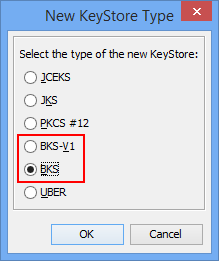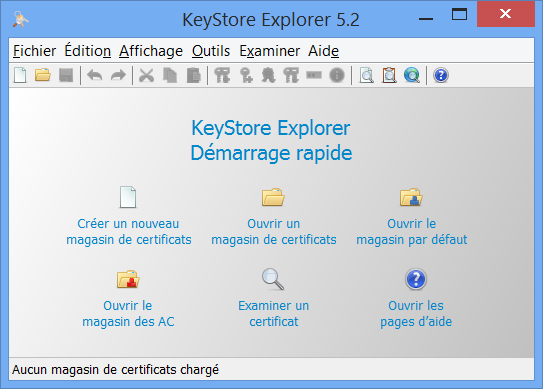
- #KEYSTORE EXPLORER COULD NOT SAVE KEYSTORE HOW TO#
- #KEYSTORE EXPLORER COULD NOT SAVE KEYSTORE INSTALL#
- #KEYSTORE EXPLORER COULD NOT SAVE KEYSTORE MANUAL#
- #KEYSTORE EXPLORER COULD NOT SAVE KEYSTORE FULL#
As a bonus it would be great if the side-project was something new.
#KEYSTORE EXPLORER COULD NOT SAVE KEYSTORE FULL#
However, to get the full benefit of working with Java and Swing what I really needed was a side-project, something outside of work where I would be free to develop as a chose, free from interference. My employer looked to be going places, the fallout from the Dot Com bubble hadn’t yet bitten and I was working with interesting technology. I may dip into these topics in later postings).Īll was well in my world. If you put in the effort into each you can reap the benefits. (WORA and Swing are much maligned but not by me. Many things interested me about the language notably its simplicity when compared to C++, the principle of Write Once Run Anywhere (WORA) and the cross-platform GUI toolkit: Swing. I had just joined an ISV in Glasgow to cross-train as a Java developer. As the utility is now almost ten years old I feel it is a good time to write a potted history of KSE.īack in mid-2001 I was a relatively green programmer with only four years of industry experience, mostly in C/C++ and RDBMS. It is only relatively recently that it was re-licensed to be free for all to use once again. KSE started as an open source project before morphing into a commercial project. These days it is a freeware offering but it has not always been that way. tProperty(“”, “ssl”) Īn important point is to remember that you need the server’s certificate file to be in your keystore, or the connection will most likely be refused.KeyStore Explorer (KSE) has existed, in one form or another, since 2002. If you’d rather use the sun tool, check out for more info.Īs far as code is concerned, you need to load your keystore into the session: To do this, you may use the keytool.exe tool provided with the Sun JDK, or use a nifty little tool such as the one you discovered – or KeyTool GUI (check out ). In order to implement secure calls to webservices, all you need to do is build a keystore containing the endpoint certificate and those of your own to close up the handshake process.
#KEYSTORE EXPLORER COULD NOT SAVE KEYSTORE HOW TO#
If you do know how to do this, please leave a comment =) The ideal would be to import the chain directly using the keystore tool, which is probably possible, I just could find exactly how. Of course, this solution is not ideal, but works.

After that, I opened the trusted store and imported all of those certificates into it.
#KEYSTORE EXPLORER COULD NOT SAVE KEYSTORE MANUAL#
Strangely, I had to do some manual labour to import the chain of certificates: I visualized, one by one, all of the certificates in the chain, and exported each one to. I installed the tool, and with some guessing I found how to visualize the. It is a free tool that really helps visualizing digital certificates, both installed and the ones available in specific certificate files. This is when I found the KeyStore Explorer application. I gave up this approach for a while and started to google around for some solution.

But I couldn’t find the proper parameters to pass to keystore so that it would do the right thing… I just knew I had to import it in my local (or server, when in production) trusted certificate store. Having never dealt with such a file before, I had no idea of what to do with it. pb7 file, which I discovered later that follows the PKCS #7 format / standard / whatever.

Sounds pretty simple, but can be a little bit troublesome if you are not familiar with how Java works with digital certificates and also with how to handle the keystore tool that comes with the JVM.Īt first, I tried to import the certificate chain using the keystore directly, without success.
#KEYSTORE EXPLORER COULD NOT SAVE KEYSTORE INSTALL#
To do this we have to, somehow, install a certificate chain provided by the Web Service provider. One of the requirements for the secure connection is that our server trusts the Web Service’s server. I’ve been playing around with digital certificates in Java, because I’ll have to implement some stuff here that requires secure calls to web services using them. Ok, one more post aimed at my memory, but that can end up helping others as well 😉


 0 kommentar(er)
0 kommentar(er)
